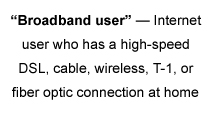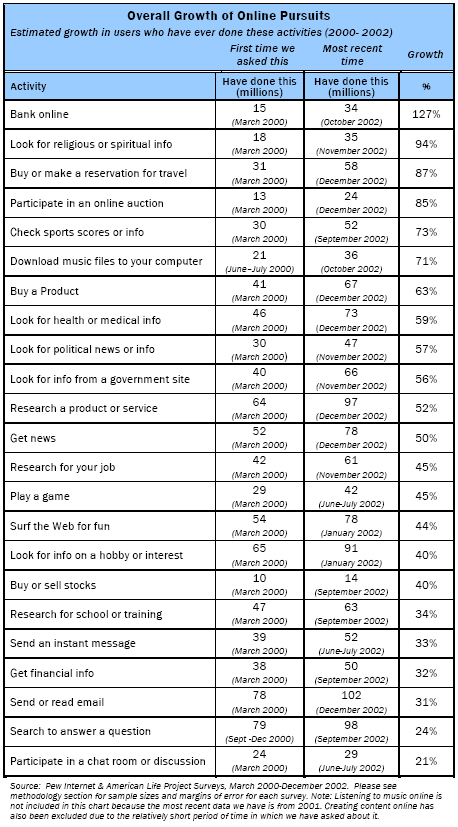The changing picture of who’s online
A broad analysis of over three years’ worth of Pew Internet Project data illustrates shifting trends in Internet use by Americans.
Among our findings about change in the Internet world over time:1
- Online activity has consistently grown over the course of our research. Internet users discover more things to do online as they gain experience and as new applications become available. This momentum often fuels increasing reliance on the Internet in everyday life and higher expectations about the way the Internet can be used in matters both mundane and mighty.
- Despite this growth in activity, the growth of the online population itself has slowed. There was almost no growth over the course of 2002 and there has been only a small uptick in recent months to leave the size of the online U.S. adult population at 63% of all those 18 and over. More than three-quarters of those between the ages of 12 and 17 use the Internet.
- Different people use the Internet in different ways. Within the online population, specific demographic groups have comparatively high incidence levels for certain online activities. For example:
» High proportions of female Internet users have done activities such as seeking health or religious information on the Internet, while a large percentage of male users have sought news, financial information, sports news, and political news.
» Among minority Internet users, a large portion of African-Americans has done research for school and sought religious and spiritual information.
» English-speaking Hispanic users report high levels of instant messaging and downloading music compared to African-Americans and whites.
» Those from high-income households and who have college degrees are more likely than those with more modest incomes and education to do a host of things online, including looking for government information, doing online banking, and participating in online auctions.
» The young like instant messaging and downloading music. Older Internet users are more likely than younger users to get health information and seek material at government Web sites. - Experience and the quality of online connections matter. Those with more experience online and those who have high-speed connections at home generally do more online more often than those with lower levels of experience and those with dial-up connections. The growth of the cohort of veteran users, those with at least three years of online experience, has been striking. Nearly three-quarters of Internet users have at least three years of experience.
- Online Americans’ experience with the commercial side of the Internet has expanded dramatically in spite of the economic slump. Financial and transaction activities such as online banking and online auctions have grown more than any other genre of activity.
- Email continues to be the “killer app” of the Internet. More people use email than do any other activity online. Many report their email use increases their communication with key family and friends and enhances their connection to them.
- Big news stories drive lasting changes in the news-seeking audience online.
Close to two-thirds of Americans now go online to access the Internet.
The number of American adults going online grew by 47% between our March 2000 and August 2003 surveys. However, growth in Internet penetration was relatively flat over the course of 2002.
- Overall, 63% of adult Americans use the Internet. The online population expanded from roughly 86 million Americans in March 2000, to 126 million in August 2003.2
- The size of the online population on a typical day grew from 52 million Americans in March 2000 to 66 million in August 2003 – an increase of 27%.
- In March 2000, 49% of American men and 44% of American women were online. By August 2003, 65% of men were online compared to 61% of women. But there are more women than men in the online population because there are more women in the country than men.
- 87% of U.S. Internet users said they have access at home and 48% said they have access at work in our August 2003 survey.
- 31% of Internet users who go online from home have broadband as of August 2003.

Internet use still differs significantly across some demographic groups.
- Internet adoption has increased in all demographic groups, but there are still pronounced gaps in Internet use along several demographic lines. Older Americans are much less wired than younger Americans; minorities are less connected than whites, those with modest amounts of income and education are less wired than those with college educations and household incomes over $75,000, those with jobs are more likely than those without jobs to have access, parents of children under 18 living at home are more likely than non-parents to be online, and rural Americans lag behind suburban and urban Americans in the online population. Disabilities also keep some Americans from using the Internet.
- There is great fluidity in the Internet population. About a quarter of Americans live lives that are quite distant from the Internet – they have never been online, and don’t know many others who use the Internet. At the same time, many Americans who do not use the Internet now were either users in the past or they live in homes with Internet connections.
Email continues to trump all as the most popular use of the Internet.
Internet users overwhelmingly rely on email as their communication tool of choice; more than nine in ten online Americans have sent or read email. In comparison, about one-half of all Internet users have tried instant messaging and one-quarter has participated in chat rooms or online discussions.
- About 102 million Americans were email users in December 2002, up 31% from 78 million in March 2000.
- Instant messaging has grown by about 33% — from 39 million who had ever tried IM as of March 2000, to 52 million in the summer of 2002. IM continues to appeal primarily to younger users.
- The number of people who have participated in chat rooms and online discussions increased by 21%.
Information-seeking activities have grown across the board since 2000 — most by 50% or more.
Overall, information-seeking activities are more prevalent among users with higher income and education levels, those with more experience online, and those with broadband access at home.
- More than eight out of ten Internet users have searched the Internet to answer specific questions.
- Spurred by an increase in content and the momentum of important news events in recent years, the online news population grew by 50%.
- As Americans developed expectations about finding vital information on the Internet, those seeking health information online grew by 59%. There were about 46 million Americans who had looked for health or medical information online as of March 2000, and the figure grew to 73 million who had done so by December 2002. In fact, the figure is closer to 93 million, if a variety of health-related searches are asked of Internet users.
- The number who seek religious information online has nearly doubled. While 18 million Americans had sought religious or spiritual information online by March 2000, approximately 35 million (94% more) reported they had done so by November 2002.
- The number of those who have used government Web sites grew by 56% between 2000 and 2002.
- Those who have searched for political news and information online grew by 57% between 2000 and 2002.
- Over half of all Internet users have done research for school or training online — in March 2000 that translated to roughly 47 million Americans who had used the Internet that way. By September 2002, those who had done education-related research had grown by 34% to 63 million Americans.
- The population of those who have done work or research for their job online (not including email) grew by 45% between March 2000 and November 2002. About 42 million had used the Web for work in 2000, and 61 million had done so in 2002.
As the online marketplace has matured; financial and transaction-based activities have grown more than any other type of online pursuit.
Similar to the pattern we have found with information-seeking activities, financial and transaction-based activities are most popular among users with greater income and education levels, those with more experience online, and those with broadband access at home.
- More than eight out of ten Internet users have researched a product or service online.
- Despite the burst of the dot-com bubble in 2000, e-purchasing continues to expand. In all, the number of people who had made purchases online grew by 63% since 2000.
- One of the fastest-growing activities we have tracked relates to travel. The number of online Americans who had bought tickets or made reservations for travel online grew by 87% between 2000 and 2002.
- The number of those who had sought financial information online, such as stock quotes or mortgage interest rates increased by 32% between 2000 and 2002.
- Online banking increased by 127% — more than any other activity about which we asked 2000 and 2002. In March 2000, just 15 million had tried some form of online banking, but by October 2002, 34 million had done so.
- About one in ten Internet users has bought or sold stocks online.
- Online auction participants have almost doubled since 2000 — there were about 24 million bidders and purchasers in the auction population by December 2002, up 85% from 13 million since March 2000.
Online Americans continue to explore new hobby and entertainment activities on the Internet.
In general, these online pursuits are more popular among the younger segments of the Internet population and those who have high-speed connections at home. Another common trend is that a higher proportion of online African-Americans and online English-speaking Hispanics do these activities compared to online whites, possibly because those online minority populations are younger than the white population.
- Three out of four Internet users have sought information about a hobby or interest online. The number of hobby seekers increased by 40% between March 2000 and January 2002 — from 65 million to 91 million.
- The number of online Americans who say they sometimes go online for no particular reason, just to browse for fun or to pass the time, has increased by 44% since March 2000. These recreational users of the Web grew from 54 million in March 2000, to 78 million in January 2002.
- The number of Internet users who downloaded music increased by 71% between 2000 and 2002. About 21 million online Americans had downloaded music files onto their computer as of the summer of 2000. By October 2002, there were an estimated 36 million users who had acquired music files this way.
- The online sports audience expanded by 73% between 2000 and 2002.
- Those who have played games online have increased by 45% — from 29 million in March 2000, to 42 million in June-July 2002.





